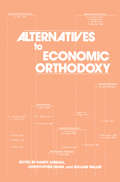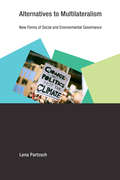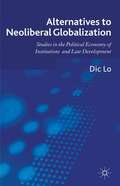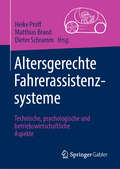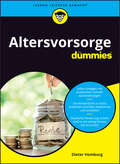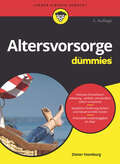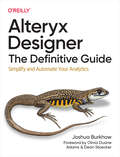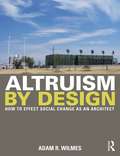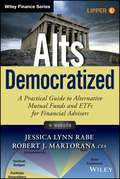- Table View
- List View
Alternatives to Economic Orthodoxy: Reader in Political Economy
by Randy AlbeldaExploring the question of whether China's peasantry was a revolutionary force, this volume pays particular attention to the first half of the 20th century, when peasant-based conflict was central to nationwide revolutionary processes. It traces key themes of social conflict and peasant resistance.
Alternatives to Multilateralism: New Forms of Social and Environmental Governance (Earth System Governance)
by Lena PartzschAnalysis and case studies of emerging forms of private, public, and hybrid social and environmental governance.The effects of globalization on governance are complex and uncertain. As markets integrate, governments have become increasingly hesitant to enforce regulations inside their own jurisdictions. At the same time, multilateralism has proven unsuccessful in coordinating states' responses to global challenges. In this book, Lena Partzsch describes alternatives to multilateralism, offering analyses and case studies of emerging--alternative--forms of private, public, and hybrid social and environmental regulation. In doing so, she offers a unique overview of cutting-edge approaches to global governance.
Alternatives to Neoliberal Globalization
by Dic LoThrough a compliance with the neoliberal doctrines associated with the Washington Consensus, and the corresponding emphasis on the privitization of public assets, the promotion of well-defined property rights and a focus on price and trade liberalisation, developing countries have been promised that 'natural economic institutions' will form. However, despite the promotion of these doctrines, the 1980s and 1990s have come to be known as the 'lost decades of development': a period of long economic stagnation in most parts of the developing world, with little sign of the income level of the developing world converging with that of developed countries. In this book, Dic Lo re-examines the mainstream policy doctrines of globalization, and formulates explanations for the uneven development of recent years. Through a comparative analysis of the actual experiences of developing nations and their policy positions, this book clarifies the positive and negative lessons that can be learned by developing countries. Dic Lo also undertakes an examination of the theoretical underpinnings of the competing doctrines of institutions and development, with a view to creating a synthesis that transcends neoliberalism, instead emphasising solidarity and humanistic development.
Alternatives to Privatization: Public Options for Essential Services in the Global South (Routledge Studies in Development and Society)
by Greg Ruiters David A. McDonaldThere is a vast literature for and against privatizing public services. Those who are against privatization are often confronted with the objection that they present no alternative. This book takes up that challenge by establishing theoretical models for what does (and does not) constitute an alternative to privatization, and what might make them ‘successful’, backed up by a comprehensive set of empirical data on public services initiatives in over 40 countries. This is the first such global survey of its kind, providing a rigorous and robust platform for evaluating different alternatives and allowing for comparisons across regions and sectors. The book helps to conceptualize and evaluate what has become an important and widespread movement for better public services in the global South. The contributors explore historical, existing and proposed non-commercialized alternatives for primary health, water/sanitation and electricity. The objectives of the research have been to develop conceptual and methodological frameworks for identifying and analyzing alternatives to privatization, and testing these models against actually existing alternatives on the ground in Asia, Africa and Latin America. Information of this type is urgently required for practitioners and analysts, both of whom are seeking reliable knowledge on what kind of public models work, how transferable they are from one place to another and what their main strengths and weaknesses are.
Alternatives to the Central Bank in the Developing World
by Charles CollynsA national central bank is usually high on the shopping list of a newly independent country. Such a country often inherits a currency board—a carryover from the colonial era—and wishes to establish a new monetary authority with far wider executive powers and public responsibilities.
Alternatives: How to Make Smarter Choices by Creating Better Alternatives to Choose From
by John S. Hammond Ralph L. Keeney Howard RaiffaAlternatives are the raw material of decision making. This chapter looks at an important element of effective decision making: creating imaginative alternatives or different courses of action you have to choose from.
Alternatives: The Source of Superior Solutions
by Richard LueckeTo make an informed decision, you must be able to look at alternative solutions and weigh the merits of those alternatives. This chapter explains how to generate other possibilities, brainstorm effectively, and combine features to create a hybrid alternative.
Altersdifferenzierte Führung zur Verbesserung des Führungserfolgs: Eine Analyse der Beziehungen zwischen Führenden und Geführten
by Anja Bendixen-DanowskiIn dieser Studie erfolgte erstmals im Rahmen der altersdifferenzierten Führungsforschung eine Analyse der Beziehungen zwischen Führenden und Geführten eines Unternehmens. Der dreistufige Mixed-Method-Ansatz umfasst qualitative Expertise-Interviews (N = 30), welche die Grundlage für eine Online-Befragung der Mitarbeitenden (N = 249, 68 %) einer digitalaffinen Firma bildeten. Im anschließend virtuell durchgeführten zweitägigen Führungskräfteworkshop (N = 30) wurden Handlungsempfehlungen abgeleitet. Diese zielten darauf ab, die Ansprüche von Berufseinsteigenden zu berücksichtigen, die Interesse an beruflicher Weiterentwicklung und abwechslungsreichen Arbeitsaufgaben zeigten. Zusammenfassend lässt sich konstatieren, dass die Bewältigung der Distanz, die durch das zweijährige Homeoffice während der COVID-19-Pandemie entstanden ist, eine anspruchsvolle Führungsaufgabe darstellt. Das Ziel der hier angestoßenen Organisationsentwicklung besteht in der langfristigen Steigerung der Arbeitszufriedenheit und Leistungsbereitschaft. Die abgeleiteten praktischen Implikationen empfehlen sich für einen Praxistransfer.
Altersgerechte Fahrerassistenzsysteme: Technische, psychologische und betriebswirtschaftliche Aspekte
by Dieter Schramm Heike Proff Matthias BrandMenschen in hoch entwickelten Ländern werden immer älter. Sie möchten im Alter mobil sein, haben jedoch oftmals Probleme im Straßenverkehr. Auch wenn sie häufig für altersgerechte Produkte, die die Sicherheit erhöhen, einen Aufpreis bezahlen, ist die Nachfrage nach Fahrerassistenzsystemen bei älteren Autofahrern bislang gering. Das Buch fasst Ergebnisse des Projektes ALFASY (ALtersgerechte FAhrerassistenzSYsteme) zusammen, in dem ein akustisches Fahrerassistenzsystem für die Bedürfnisse der stetig wachsenden Gruppe der älteren Fahrerinnen und Fahrer (50 Jahre und älter) entwickelt und aufgebaut wird. Untersucht wurden technische, psychologische und betriebswirtschaftliche Aspekte.
Altersvorsorge am Scheideweg: Erfolgreiche Strategien gegen Altersarmut
by Heinz Benölken Nils BröhlAnbieter und ihre Vertriebspartner können durch gute „ganzheitliche“ Beratung an der Altersvorsorge ihrer Kunden dann verdienen, wenn sie sich in deren Bedarfssituation versetzen und Produkte in der richtigen Reihenfolge anbieten, bei denen Kunden inklusive staatlicher Förderung eine faire Nettoverzinsung erzielen. Damit kommen die Autoren zu einem wichtigen Punkt: Altersvorsorge ist Absicherung fürs Alter und nicht mit Spekulation zu verwechseln. Verluste führen hier nicht nur zur Katerstimmung am Morgen danach, sondern können der Einstieg in Altersarmut sein. Altersvorsorgesparen ist ein Sparvorgang mit dem Ziel, den Endwert des Sparvermögens zu maximieren. Dazu braucht der Bürger eine hohe Transparenz im Altersvorsorge-Dschungel von Riester-, Rürup- und bAV-Produkten sowie weiteren Anlagen, durch die der Leser dieses Buches geführt wird.
Altersvorsorge für Dummies (Für Dummies)
by Dieter HomburgSofort loslegen mit praktischen Schnellstartanleitungen Die Rentenlücke in sechseinfachen Schritten bestimmen und schließen Staatliche Förderung nutzen und so mit wenig Einsatz viel erreichen Entspannt und finanziell abgesichert ins Alter Fehlt Ihnen die Zeit, sich um Ihre Rente zu kümmern? Haben Sie das Gefühl, eh nicht genug beiseitelegen zu können, ohne Ihren derzeitigen Lebensstandard senken zu müssen? Sich rechtzeitig um die Altersvorsorge zu kümmern, ist ein Muss für jeden. Dieter Homburg unterstützt Sie dabei, dieses leidige Thema endlich anzugehen, einen Kassensturz zu machen, die Rentenlücke zu ermitteln und systematisch zu schließen – und das auch mit wenig Rücklagen, indem Sie Zuschüsse clever nutzen und geeignete Anlagemöglichkeiten auswählen. So können Sie entspannt älter werden und wissen: Sie sind gut versorgt! Sie erfahren Welche Anlagen mit dem geringsten Aufwand am meisten bringen Welche Vorsorgemöglichkeiten sich heute noch lohnen Wie Sie bestehende Lebensversicherungen auf den Prüfstand stellen
Altersvorsorge für Dummies (Für Dummies)
by Dieter HomburgMöchten auch Sie in Würde und selbstbestimmt bis ins hohe Alter leben? Aber wie, wo es heute fast keine Zinsen mehr gibt und die staatliche Rente auch nicht die Rettung sein wird? Richtig, in dem Sie es selbst in die Hand nehmen. Hierbei hilft Ihnen dieses Buch. In nur wenigen Stunden können Sie mithilfe einer praktischen Schnellstart-Anleitung Ihren konkreten Rentenfahrplan erstellen. Räumen Sie mit zu teuren und überflüssigen Versicherungen und Sparverträgen auf, senken Sie Ihre Steuerlast und zapfen Sie intelligent staatliche Fördertöpfe an. Das Ergebnis: mehr Altersvorsorge ohne einen Cent mehr auszugeben.
Alteryx Designer: Simplify and Automate Your Analytics
by Joshua BurkhowAnalytics projects are frequently long, drawn-out affairs, requiring multiple teams and skills to clean, join, and eventually turn data into analysis for timely decision-making. Alteryx Designer changes all of that. With this low-code, self-service, drag-and-drop workflow platform, new and experienced data and business analysts can deliver results in hours instead of weeks.This practical book shows you how to master all areas of Alteryx Designer quickly. Author and Alteryx ACE Joshua Burkhow starts with the basics of building a workflow, then introduces more than 200 tools for working with intermediate and advanced analytics functionality. With Alteryx Designer's all-in-one toolkit, you'll migrate from legacy analytics software or Excel with ease.Ready to work with data quickly and efficiently? This guide gets you started.Learn the fundamentals of cleaning, prepping, and analyzing data with Alteryx DesignerInstall, navigate, and quickly become competent with the Alteryx Designer layout and functionalityConstruct accurate, performant, reliable, and well-documented workflows that automate business processesLearn intermediate techniques using spatial analytics, reporting, and in-database toolsDive into advanced Alteryx capabilities, including predictive and machine learning toolsGet introduced to the entire Alteryx Analytic Process Automation (APA) Platform
Altius Golf and the Fighter Brand
by Robert J. Dolan Sunru YongAltius Golf is the clear leader in the golf ball market despite a long-term decline in the number of golfers and a drop in sales following the financial crisis. The firm has maintained its position by introducing generations of advanced, super-premium golf balls that allow their customers to emulate professional golfers. The company has been losing market share to lower-priced competitors and the CEO wants to introduce a new program called Elevate to foster the next generation of golfers. With Elevate, the firm will introduce a ball that is more forgiving and easier to drive for distance and offer it at a price 40% below the company's flagship brand. Elevate will be available through "off-course" channels such as golf specialty stores and big box retailers instead of "on-course" pro shops where the firm typically sells its products. The board of directors is divided on whether to support the decision. Students must perform a quantitative analysis of the CEO's proposal to understand the potential risks and gains before making a final recommendation.
Altoona State Investment Board & Bain Capital Fund XI
by Josh Lerner Ted BerkConsiders the decision faced by state pension fund manager Rod Calhoun as he decides whether to invest $200 million in Bain Capital's eleventh global buyout fund: Bain Capital Fund XI. For the fund, Bain was offering its limited partners a choice between three different fee structures: first, a "conventional" fee structure of a 1.5% management fee with 20% carried interest and a 7% preferred rate of return; second, a 1% management fee with 30% carried interest and a 7% preferred rate of return; or third, a 0.5% management fee, 30% carried interest, and a 0% preferred rate of return. Should Calhoun invest in Bain? If he should, which fee structure should Calhoun choose?
Altoona State Investment Board: December 2008
by Josh LernerRod Calhoun, the head of the Altoona State Investment Board's private equity investment program, considered the communication he had just received. It was from Permira, the leading European buyout fund, and concerned its fourth fund, to which Altoona had made a 100 million commitment. The memorandum offered investors a chance to reduce their commitment to Permira IV. This potential offer was an attractive one, as it would allow the state pension to address its "over-commitment problem," one that plagued many institutional investors. But the terms of the arrangement gave Calhoun pause.
Altoona State Investment Board: July 2012
by Josh Lerner Nathaniel BurbankConsiders the decision faced by state pension fund manager Rod Calhoun as he decides whether to invest $200 million in Bain Capital's eleventh global buyout fund: Bain Capital Fund XI. For the fund, Bain was offering its limited partners a choice between three different fee structures: first, a "conventional" fee structure of a 1.5% management fee with 20% carried interest and a 7% preferred rate of return; second, a 1% management fee with 30% carried interest and a 7% preferred rate of return; or third, a 0.5% management fee, 30% carried interest, and a 0% preferred rate of return. Should Calhoun invest in Bain? If he should, which fee structure should Calhoun choose?
Altos Ventures (A)
by Jo Tango Alys FerragamoIn December 2012, Altos Ventures General Partners Han Kim, Anthony Lee, and Ho Nam met to discuss the future of the firm. Altos had already adjusted its strategy multiple times. It began as a U.S.-focused venture capital investor whose first two funds were backed by a sole limited partner, a South Korean financial conglomerate. In late 2001, the partners made their first transformative decision, raising a fund from traditional institutional LPs to focus on bootstrapped technology companies. In 2008, Altos again refined its strategy, this time to fund similar capital-efficient companies but with more "explosive growth" potential. Now, in 2012, the firm was running out of capital and did not have the realized track record to raise another traditional institutional fund. They considered two options: raise a South Korea-focused VC fund or offer more co-investment opportunities to LPs through a "mini" fund. What should Altos do to stay afloat?
Altos Ventures (B)
by Jo Tango Alys FerragamoIn December 2021, Han Kim, Anthony Lee, and Ho Nam reflected on how far they had come since 2012. This B case provides an update on Altos Ventures' decision-making and performance since the events presented in the A case.
Altruism by Design: How To Effect Social Change as an Architect
by Adam R. WilmesAltruism by Design: How to Effect Social Change as an Architect is meant to prepare the individual designer – whether a student or practicing professional – for a career dedicated to serving communities in need through design and construction. It will help you understand the complexities, opportunities, and benefits of creating architecture that promotes social equality and community so that you can make a difference. What you'll learn: -How community-based studios can respond to natural disasters and economic conditions-How to build what you design-How to develop relationships with non-traditional clients-How to structure your career to be dedicated to social change and sustainable design-How to discover funding opportunities for projects in a not-for-profit firm-How to consider moral and financial aspects of your practice-How you can collaborate with other design professions to determine the future of the built environment Featuring detailed case studies, including work by Studio 804 and Pyotak Architects, and more than 100 color images; this book is essential reading for providing you with a viable path to altruistic design.
Alts Democratized
by Jessica Lynn Rabe Robert J. MartoranaA Comprehensive Review of the Liquid Alts Market and How '40 Act Products Can Enhance Client PortfoliosLiquid alternatives give investors access to hedge fund strategies with the benefits of '40 Act products: lower fees, higher liquidity, greater transparency, and improved tax efficiency.Alts Democratized is a hands-on guide that offers financial advisors and individual investors the tools and analysis to enhance client portfolios using alternative mutual funds and ETFs. Well-grounded in research and replete with more than 100 exhibits of Lipper data, Alts Democratized profiles the top ten funds in each of the eleven Lipper liquid alt classifications. This includes total net assets, fund flows, risk and return metrics, and the factor exposures that drive performance and help explain correlations to various forms of beta. Jessica Lynn Rabe and Robert J. Martorana, CFA, combine this research with a comprehensive framework for fund selection and portfolio construction to enhance the asset allocation process, facilitate portfolio customization, and manage client expectations.In addition, the book includes functional perspectives on issues pertinent to financial advisors such as fees, client suitability, and volatility management. This helps advisors apply the concepts to portfolios and offer actionable investment advice. The authors also interviewed executives at leading wealth management firms to provide color on industry trends and best practices.The companion website provides ancillary materials that reinforce and supplement the book, including:The authors' top ten takeawaysClassification cheat sheetPortfolio construction guide (full color)Talking points for clientsQ&A on liquid altsPresentation with all 118 exhibits from the book (full color) Alts Democratized comprises a complete resource for the advisor seeking new sources of alpha, diversification, and hedging of tail risks.
Aluminium Bahrain (Alba): The Pot Line 5 Expansion Project
by Aldo Sesia Benjamin C. EstyIn September 2002, Aluminium Bahrain (Alba) needed to decide how to finance its proposed $1.7 billion pot line. The company's financial adviser, Taylor De-Jongh (TDJ), had recommended Alba employ a multisourced financing strategy using as many as five sources of debt from international, regional, and local capital pools. TDJ believed that the strategy would generate competition among the lenders which, in turn, would save Alba millions in financing costs. But the multisourced financing strategy went against the grain of typical project financings in the Middle East and was not without its risks. Alba management must decide how many financing sources to use, which ones, and how much to get from each one. If the market rejects the multisourced financing strategy, the project might become tainted, which could jeopardize Alba's long-term growth objectives.
Aluminum Industry in 1994
by Kenneth CortsAfter reaching all-time highs in excess of $2,500 per ton in 1988 and 1989, aluminum prices fall dramatically in the early 1990s as the former Soviet Union begins exporting far larger quantities of metal. By the beginning of 1994, the price has hit all-time lows (in real terms) and stands at $1,110. The case contains data on world consumption by sector; an accompanying spreadsheet contains detailed cost data for the world's 157 smelters. Together, these allow a thorough supply and demand analysis that illuminates price fluctuations in this industry. A rewritten version of an earlier note.
Aluminum Smelting in South Africa: Alusaf's Hillside Project
by Kenneth CortsWith prices at all-time lows at the beginning of 1994, South Africa's sole primary aluminum producer--Alusaf--is considering building the world's largest greenfield smelter. Using cost estimates in this case, students can evaluate the relative cost position of this plant in the context of the cost data on other smelters provided in the spreadsheet accompanying "The Aluminum Industry in 1994." By building on the supply and demand analysis supported by that case, students can evaluate the profitability of this massive capital investment.
Alumni Leadership and University Excellence in Africa: The Case of Lagos Business School (Palgrave Studies in African Leadership)
by Henry O. OnukwubaFocusing on Lagos Business School (LBS) in Nigeria, this book explores the impact of strong alumni leadership on university excellence in Africa. Strong leadership is crucial to the success of educational institutions and great importance is placed on their effective governance and management. However, many institutions fail to realise the positive impact that a strong alumni body can have on university excellence. Drawing on definitions and theories of leadership, the author seeks to establish the significance of alumni in enhancing a university’s growth and development. Providing comprehensive analysis of LBS, this book is a unique resource for leaders of educational institutions, as well as those studying and teaching in African business schools.
